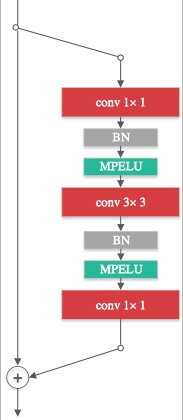- November 2, 2023: Added support for Mixed Precision
- March 14, 2023: Added support for PyTorch (latest for pytorch 2.1.0)
Code for Improving Deep Neural Network with Multiple Parametric Exponential Linear Units, arXiv:1606.00305
The main contributions are:
- A new activation function, MPELU, which is a unified form of ReLU, PReLU and ELU.
- A weight initialization method for both ReLU-like and ELU-like networks. If used with the ReLU nework, it reduces to Kaiming initialization.
- A network architecture that is more effective than the original Pre-/ResNet.
@article{LI201811,
title = "Improving deep neural network with Multiple Parametric Exponential Linear Units",
journal = "Neurocomputing",
volume = "301",
pages = "11 - 24",
year = "2018",
issn = "0925-2312",
doi = "https://doi.org/10.1016/j.neucom.2018.01.084",
author = "Yang Li and Chunxiao Fan and Yong Li and Qiong Wu and Yue Ming"
}
MPELU nopre bottleneck architecture:
MPELU is initialized with alpha = 0.25 or 1 and beta = 1. The learning rate multipliers of alpha and beta are 5. The weight decay multipliers of alpha and beta are 5 or 10. The results are reported as best(mean ± std).
| MPELU nopre ResNet | depth | #params | CIFAR-10 | CIFAR-100 |
|---|---|---|---|---|
| alpha = 1; beta = 1 | 164 | 1.696M | 4.58 (4.67 ± 0.06) | 21.35 (21.78 ± 0.33) |
| alpha = 1; beta = 1 | 1001 | 10.28M | 3.63 (3.78 ± 0.09) | 18.96 (19.08 ± 0.16) |
| alpha = 0.25; beta = 1 | 164 | 1.696M | 4.43 (4.53 ± 0.12) | 21.69 (21.88 ± 0.19) |
| alpha = 0.25; beta = 1 | 1001 | 10.28M | 3.57 (3.71 ± 0.11) | 18.81 (18.98 ± 0.19) |
The experimental results in paper were conducted in torch7. But we also provide pytorch and caffe implementations. If you want to use the torch7 version to replicate our results, please follow the steps below:
- Install fb.resnet.troch
- Follow our instructions to install MPELU in torch.
- Copy files in
mpelu_nopre_resnettofb.resnet.torchand overwrite the original files. - Run the following command to train a 1001-layer MPELU nopre ResNet
th main.lua -netType mpelu-preactivation-nopre -depth 1001 -batchSize 64 -nGPU 2 -nThreads 12 -dataset cifar10 -nEpochs 300 -shortcutType B -shareGradInput false -optnet true | tee checkpoints/log.txt
We now provide PyTorch, Caffe and Torch7(deprecated) implementations.
The pytorch version is implemented using CUDA for fast computation. The code has been tested in Ubuntu 20.04 with CUDA 11.6. The implementation is isolated from your PyTorch library and does not modify any other Python packages installed on your system. It can be installed and uninstalled independently using the pip package manager, and therefore can be used alongside your original PyTorch library without interfering with its functionality. You may integrate them into your projects as needed.
-
cd ./pytorch -
pip install .
-
Download the latest
caffefrom https://github.com/BVLC/caffe -
Move
caffe/*of this repo to thecaffedirectory and follow the instruction to compile.
-
Update
torchto the latest version. This is necessary because of #346. -
Move
torch/extrain this repo to the official torch directory and overwrite the corresponding files. -
Run the following command to compile new layers.
cd torch/extra/nn/
luarocks make rocks/nn-scm-1.rockspec
cd torch/extra/cunn/
luarocks make rocks/cunn-scm-1.rockspec
Examples:
# install MPELU first, then
python examples/mnist_mpelu.py
To use the MPELU module in a neural network, you can import it from the mpelu module and then use it as a regular PyTorch module in your network definition.
For example, let's say you have defined the MPELU module in a file called mpelu.py. To use it in a neural network, you can do the following:
import torch
from mpelu import MPELU
class MyNet(torch.nn.Module):
def __init__(self):
super(MyNet, self).__init__()
self.conv1 = torch.nn.Conv2d(3, 16, kernel_size=3, stride=1, padding=1)
self.mpelu1 = MPELU(16)
self.conv2 = torch.nn.Conv2d(16, 32, kernel_size=3, stride=1, padding=1)
self.mpelu2 = MPELU(32)
self.fc = torch.nn.Linear(32 * 8 * 8, 10)
def forward(self, x):
x = self.conv1(x)
x = self.mpelu1(x)
x = self.conv2(x)
x = self.mpelu2(x)
x = x.view(-1, 32 * 8 * 8)
x = self.fc(x)
return x
MPELU:
In caffe, MPELU exists as the M2PELU layer, where 2 for two parameters alpha and beta which are both initialized as 1 in default.
To simply use this layer, replace type: "ReLU" with type: "M2PELU" in network defination files.
Taylor filler:
First, replace the keyword gaussian or MSRA with taylor in the weight_filler domain. Then, Add two new lines to specify values of alpha and beta:
weight_filler {
type: "taylor"
alpha: 1
beta: 1
}
See the examples for details.
I implemented two activation functions, SPELU and MPELU, where SPELU is a trimmed version of MPELU and can also be seen as a learnable ELU.
nn.SPELU(alpha=1, nOutputPlane=0)
nn.MPELU(alpha=1, beta=1, nOutputPlane=0)
- When
nOutputPlane = 0, thechannel-sharedversion will be used. - When
nOutputPlaneis set to the number of feature maps, thechannel-wiseversion will be used.
To set the multipliers of weight decay for MPELU, use the nnlr package.
$ luarocks install nnlr
require 'nnlr'
nn.MPELU(alpha, beta, channels):learningRate('weight', lr_alpha):weightDecay('weight', wd_alpha)
:learningRate('bias', lr_beta):weightDecay('bias', wd_beta)
Taylor filler: Please check our examples in mpelu_nopre_resnet.
